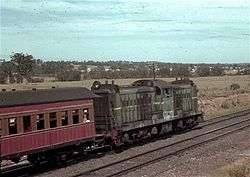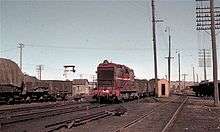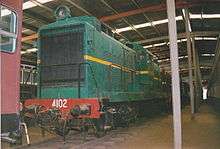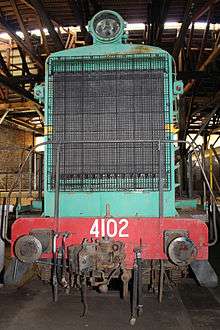New South Wales 41 class locomotive
| New South Wales 41 class | |||||||||||||||||||||||||||||||||||||||||||||||
|---|---|---|---|---|---|---|---|---|---|---|---|---|---|---|---|---|---|---|---|---|---|---|---|---|---|---|---|---|---|---|---|---|---|---|---|---|---|---|---|---|---|---|---|---|---|---|---|
 4105 heading for Campbelltown in March 1961 | |||||||||||||||||||||||||||||||||||||||||||||||
| |||||||||||||||||||||||||||||||||||||||||||||||
| |||||||||||||||||||||||||||||||||||||||||||||||
| |||||||||||||||||||||||||||||||||||||||||||||||
| |||||||||||||||||||||||||||||||||||||||||||||||
The 41 class were a class of diesel locomotives built by British Thomson-Houston in the United Kingdom for the New South Wales Government Railways in 1953 and 1954.
History



In 1950 the New South Wales Government Railways ordered 10 diesel locomotives from Australian General Electric.[1] The construction was sublet to British Thomson-Houston of Rugby in the United Kingdom with the body built by Metro Cammell, Birmingham.[2][3] The first entered service in December 1953 and the last in February 1955.[4] All were delivered painted in verdant green, in the 1960s all were repainted Indian red.
From their earliest days the locomotives suffered failures including overheating and fires. To try and overcome this the radiators were relocated further to the ends of all ten of the locomotives and air ducting was modified. In addition, two had their mufflers relocated. The modification was considered a success, but not rolled out across the rest of the class. The locomotives were equipped to operate in multiple however the cooling system layout saw radiator heat passing from the leading locomotive to the trailing one, resulting in the equipment being removed.[1]
By the early 1960s with the twin Paxman 12-RPHL engines coming to the end of their useful life, the Mechanical Branch began looking at repowering options. With the cost of repowering and overhauling the Class 41s being two-thirds that of a new Class 48 and repair costs per mile over nine times greater, it was decided not to proceed with this.[1]
One was set aside in December 1957 following two electrical fires, the second in April 1961, the third in September 1969, while overhauls ceased for the rest of the class in 1972 with each locomotive withdrawn as it suffered a major failure, the final locomotive being withdrawn in June 1975.[1] The class were mainly confined to metropolitan Sydney operating local trip workings and shunting at Enfield yard.[1]
Preservation
In December 1976, 4102 was placed by the Public Transport Commission in the custody of the NSW Rail Museum and is now a designated NSW heritage item.[5][6]
After it arrived at Thirlmere in January 1977, the seized engine that led to its demise was temporarily repaired by members of the Illawarra Group. In 1982 an engine failed whilst returning from a trip to Picton and as a consequence 4102 was then used as a one-engine shunter until the batteries finally wore out in 1987.
By July 1991 it had moved to CountryLink's XPT Service Centre in Sydenham (where the Paxman engined XPTs are maintained), where a spare engine was installed.[7] It returned to Thirlmere in November 1992, but was not restored to service.[8] In April 2009 4102 was moved for further storage at the Broadmeadow Locomotive Depot.
Status table
| Number | Serial No | Entered Service | Last Used | Withdrawn | Condemned | Scrapped | Kilometres Travelled |
|---|---|---|---|---|---|---|---|
| 4101 | 1001 | 1 Dec 1953 | 6 Jun 1973 | 27 Jun 1973 | 2 Sep 1974 | 11 Jun 1975 | 463,514 |
| 4102 | 1002 | 30 Oct 1953 | 30 Jun 1975 | 19 Jul 1975 | 1 Dec 1975 | Preserved THNSW | 492,650 |
| 4103 | 1003 | 18 Jan 1954 | 2 Apr 1974 | 16 May 1974 | 2 Sep 1974 | 1 Sep 1975 | 462,871 |
| 4104 | 1004 | 13 Jan 1954 | 12 Oct 1973 | 26 Mar 1974 | 2 Sep 1974 | 29 Aug 1975 | 440,810 |
| 4105 | 1005 | 8 Feb 1954 | 31 Mar 1961 | 01 Apr 1961 | May 1973 | 5 Oct 1972 | 149,281 |
| 4106 | 1006 | 21 Jan 1954 | 02 Jan 1958 | 05 Jan 1958 | May 1973 | 27 Apr 1973 | 106,909 |
| 4107 | 1007 | 25 Jan 1954 | 11 Aug 1973 | 26 Mar 1974 | 2 Sep 1974 | 29 Aug 1975 | 446,167 |
| 4108 | 1008 | 22 Feb 1954 | 10 Sep 1969 | 10 Sep 1969 | May 1973 | 20 Oct 1972 | 402,026 |
| 4109 | 1009 | 11 Mar 1954 | 9 Feb 1972 | 27 Jun 1973 | 2 Sep 1974 | 4 Jun 1975 | 426,074 |
| 4110 | 1010 | 10 Feb 1955 | 20 May 1974 | 25 May 1974 | 2 Sep 1974 | 1 Sep 1975 | 476,489 |
References
- 1 2 3 4 5 Leaver, Allan (January 1984). "41 Class Album". Roundhouse.
- ↑ "The 41-Class Diesel-Electric Locomotive". Australian Railway Historical Society Bulletin. January 1954. pp. 1–3.
- ↑ 41 Class Railpage
- ↑ Class 41 Vicsig
- ↑ RailCorp S170 Heritage & Conservation Register RailCorp
- ↑ Locomotive, Diesel 4102 NSW Government Environment & Heritage
- ↑ "4102" Railway Digest August 1991 page 282
- ↑ "Locomotives and Traffic 4102" Railway Digest March 1993 page 108
Further reading
| Wikimedia Commons has media related to New South Wales 41 class locomotive. |
- New South Wales Rail System Locomotives. Sydney: Archives Section, State Rail Authority of New South Wales. 1984.